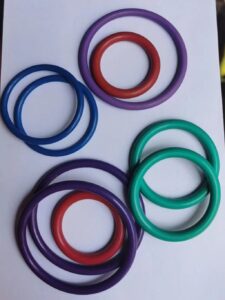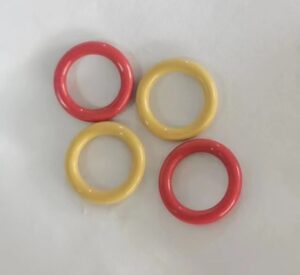Table of Contents
ToggleWhat Is the Best O-Ring Material for Engine Oil?
Selecting the optimal O-ring material for engine oil applications demands careful evaluation of temperature resistance, chemical compatibility, durability, and cost-efficiency. While multiple elastomers are viable, nitrile rubber (NBR) stands out as the industry standard for most scenarios. Below is a detailed analysis of top materials, their strengths, limitations, and ideal use cases to help engineers and technicians make informed decisions.



1. Top Contenders for Engine Oil Applications
A. Nitrile Rubber (NBR/Buna-N)
- Temperature Range: -40°C to +120°C (short-term up to 150°C).
- Advantages:
- Superior Oil/Fuel Resistance: Excels against petroleum-based oils, greases, and fuels.
- Cost-Effective: Widely available and budget-friendly.
- Abrasion Resistance: Suitable for dynamic applications like rotating shafts.
- Limitations:
- Degrades in high-temperature zones (>120°C) near exhaust systems.
- Swells in biofuels or synthetic esters (common in modern oils).
- Best For:
- Oil pans, fuel filters, transmission systems (non-extreme heat areas).
B. Hydrogenated Nitrile (HNBR)
- Temperature Range: -30°C to +150°C (short-term up to 170°C).
- Advantages:
- Enhanced Heat/Chemical Stability: Resists oxidation, ozone, and additives like detergents.
- Durability: Handles higher pressures and dynamic stress than NBR.
- Limitations:
- Higher cost than NBR.
- Limited compatibility with biofuels (e.g., E85).
- Best For:
- Turbocharger seals, high-pressure fuel injectors, synthetic oil environments.
C. Viton® (Fluorocarbon Rubber, FKM)
- Temperature Range: -20°C to +200°C (short-term up to 250°C).
- Advantages:
- Extreme Heat/Chemical Resistance: Ideal for synthetic oils, biofuels, and acidic byproducts.
- Low Compression Set: Maintains sealing force over time.
- Limitations:
- Stiffens below -15°C (requires GLT grades for sub-zero use).
- High cost compared to NBR/HNBR.
- Best For:
- High-heat zones (cylinder heads, exhaust manifolds), diesel engines.
D. Fluorosilicone (FVMQ)
- Temperature Range: -60°C to +200°C.
- Advantages:
- Wide Thermal Flexibility: Combines silicone’s low-temperature performance with fluorocarbon’s oil resistance.
- Limitations:
- Expensive and lower tensile strength.
- Best For:
- Aerospace/racing engines with extreme temperature swings, cold-climate applications.
2. Material Comparison: Key Metrics
| Material | Temp Range | Oil/Fuel Resistance | Cost | Best Use Case |
| NBR | -40°C to +120°C | Excellent (petroleum) | Low | Oil pans, low-heat engine zones |
| HNBR | -30°C to +150°C | Very Good | Moderate | Turbo seals, fuel injectors |
| Viton® | -20°C to +200°C | Exceptional | High | Cylinder heads, exhaust systems |
| FVMQ | -60°C to +200°C | Good | Very High | Extreme thermal cycling |
3. Why Nitrile (NBR) Is the Best Overall Choice
For most engine oil applications, NBR remains the gold standard due to:
- Proven Performance: Decades of reliable use in automotive seals.
- Cost Efficiency: Ideal for mass production and maintenance.
- Adequate Temperature Range: Covers typical engine operating conditions (-30°C to +120°C).
- Chemical Suitability: Resists petroleum-based oils and additives like zinc and detergents.
Exceptions:
- High-Performance Engines: Use Viton® for extreme heat (>150°C) or synthetic oils.
- Cold Climates: Opt for FVMQ or low-temperature Viton grades (GLT).
4. Critical Considerations for Material Selection
Oil Additives
Modern engine oils contain detergents, anti-wear agents (e.g., zinc), and biofuels. Viton® and HNBR resist these additives best.
Dynamic vs. Static Seals
- Dynamic Seals (e.g., crankshafts): Prioritize abrasion-resistant materials like HNBR or FKM.
- Static Seals (e.g., oil pan gaskets): Use cost-effective NBR.
Temperature Extremes
- Cold Climates: FVMQ or Viton® GLT (-45°C).
- High-Heat Zones: Viton® or specialty HNBR.
5. Materials to Avoid
- Silicone (VMQ): Swells and degrades in oil.
- EPDM: Resists coolant but fails with petroleum oils.
- Neoprene: Limited temperature and chemical resistance.
6. Final Recommendations
- Best Overall: NBR for cost, availability, and compatibility with standard engine oils.
- High-Performance Engines: Viton® for heat, synthetic oils, and biofuel blends.
- Balanced Use: HNBR for moderate heat and dynamic stress.
Validation: Always cross-check with SAE J200 or ASTM D2000 standards and manufacturer compatibility charts (e.g., Parker Hannifin).
Key Takeaways
- NBR is the best choice for most engine oil applications due to its balance of performance, cost, and reliability.
- Viton® and HNBR address niche needs like extreme heat or chemical exposure.
- Avoid materials like silicone or EPDM that lack oil resistance.
By aligning material properties with operational demands, engineers can ensure leak-free performance, extended seal life, and reduced maintenance costs in automotive and industrial systems.



Leave A Comment